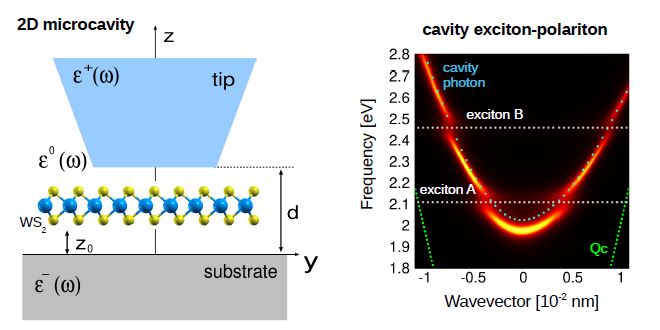This website uses cookies to ensure a better user experience.
To get more information, please read our Cookie Statement.
Cavity exciton polaritons in two-dimensional semiconductors from first principles
Our colleagues Dino Novko and Vito Despoja have published a paper in Physical Review Research in a Letter format. The authors present a fully ab initio microscopic theory that is able to simulate a formation of exciton polaritons in realistic two-dimensional microcavity devices.
Cavity exciton polaritons in two-dimensional semiconductors from first principles
Dino Novko and Vito Despoja, Physical Review Research 3 L032056 (2021).
DOI: 10.1103/PhysRevResearch.3.L032056
A two-dimensional (2D) semiconducting microcavity, where exciton polaritons can be formed, constitutes a promising setup for exploring and manipulating various regimes of light-matter interaction. Here, the coupling between 2D excitons and metallic cavity photons is studied by using a first-principles propagator technique. The strength of exciton-photon coupling is characterized by its Rabi splitting to two exciton polaritons, which can be tuned by cavity thickness. Maximum splitting of 128 meV is achieved in the phosporene cavity, while a remarkable value of about 440 meV is predicted in a monolayer hexagonal boron nitride device. The obtained Rabi splittings in a WS2 microcavity are in excellent agreement with recent experiments. The present methodology can aid in predicting and proposing potential setups for trapping robust 2D exciton-polariton condensates.
Figure 1. Left panel: The schematic of a microcavity device. The 2D crystal described by optical conductivity σ(ω) is inserted in the microcavity which consists of the substrate, the dielectric media and the tip described by the macroscopic dielectric functions ϵ−(ω), ϵ0(ω), and ϵ+(ω), respectively. Right panel: The intensity of electromagnatic modes showing the hybridization between cavity mode n = 1 (turquoise dotted) and the WS2 A and B excitons (white dotted) in silver cavity of thickness d = 260 nm.





